Every Autumn at the Schlitz Audubon Nature Center, there is at least one perfect day: the sky is a brilliant shade of blue; the colors of the leaves reach their peak - dazzling us with vivid yellows, reds, and browns. The temperature is exactly right, and even the ground is warm and dry. When such a day arrives, those of us who teach in the preschool eagerly pack up brushes, paints, and cardboard easels and head for the trails with sixteen small children. Sometimes we visit the ravine. Sometimes we opt for the large covered porch with its wonderful views of Lake Michigan. But more often than not, we opt for the pond, with its grassy banks, its wide wooden deck, and the water lilies, changing from green to red, spread across the water.
The children spread out too, side-by-side, with easels perched on their knees, sharing watercolor paints while the sun shines down on their bright white paper. Some of the children are skeptical. They have no interest in art, or paints, or sitting still. Some have no interest in the changing colors, or the water lilies: their interest is in mud, or frogs, or the possibility of sliding down the embankment in the hopes of getting their feet wet.

We have been taking children outdoors to paint with watercolors for the past several years, and while every painting has been different, just as every child has been different, one thing has remained consistent: the children sit for this activity. They focus. They grow calm. They often forget to talk. The warmth of the sun is on their heads; the breeze is all around them. Some only sit for a short while. But most will easily last five minutes, which says a lot when the child is only three years old. And some children can sit ten minutes or longer, captivated by the mixing of colors, and the dipping of their brush in water.
When we talk, as we sometimes do in our preschool teacher meetings, of helping children develop an environmental ethic, of helping them to feel safe in nature, and hoping that they will ultimately derive some kind of comfort from being outside, it develops, I believe, in moments like this. When given the opportunity to create something personal, to observe something beautiful, and to sit in a group of classmates, outside, on a perfect autumn day, children inevitably feel safe. They feel peaceful. They feel curious, and calm, and content all at once.

The teachers lay their artwork in the sun to finish drying, and we give them time now to explore the pond: to lay on their stomachs across the dock to peer into the water, to dip their nets if we brought any, to touch the mud, if there is any. The paintings will be gathered, placed into journals, and eventually given to parents. Anyone looking at the wrinkled paper will most likely see swirls of color, muddy brown puddles, or robots, painted all in blue. But what is really pictured is a perfect fall day: sunshine, mud, and a moment of childhood, captured en plein air.
For strategies for taking children outdoors derived from Schlitz Audubon Nature Center Preschool, see Catherine's blog post, Twenty Ways to Take Art Outside.
About the Author
Catherine Koons Hubbard is a Nature Preschool Teacher at the Schlitz Audubon Nature Center in Milwaukee, Wisconsin. She has also taught Environmental Education in Oregon, New Mexico, and North Philadelphia. She is not an artist, and does not believe that her preschool students need to have any artistic skill in order to wield a paintbrush. For her, experiencing art in nature is all about feeling the sun and the wind, listening to the leaves and the call of the birds, and finding contentment outdoors.


